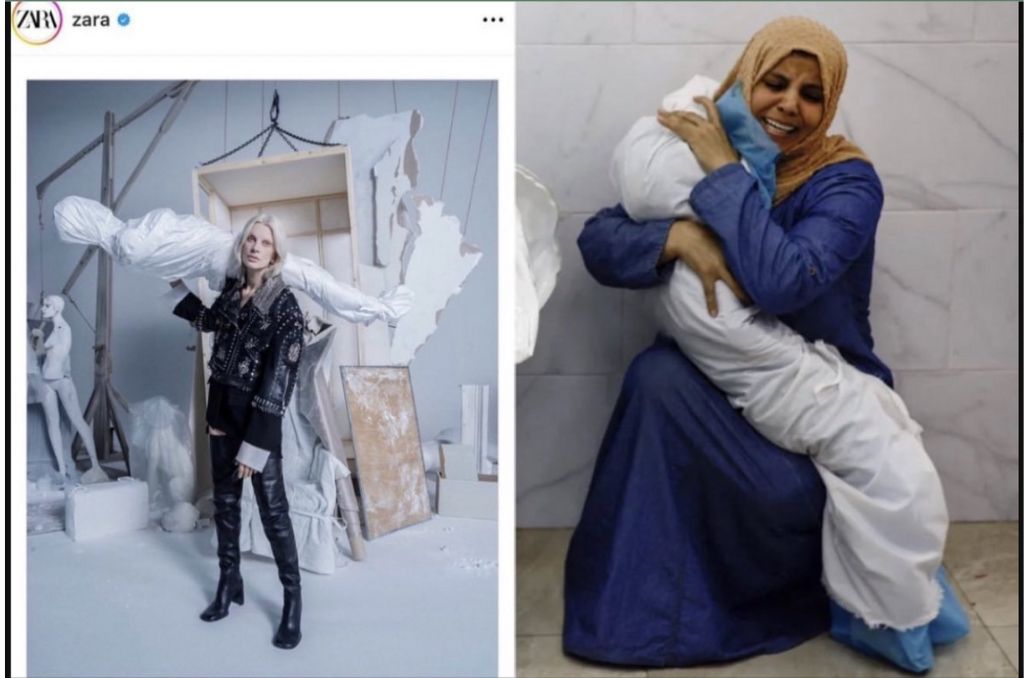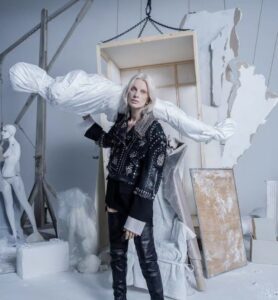
Campaign — Zara, the fast fashion behemoth, released a campaign for its higher-end Atelier line entitled The Jacket in December. The work was meant to evoke the messy interior of a sculptor’s studio, complete with unfinished life-size human sculptures and broken-down plaster building materials.
Instead, the imagery was perceived by many as egregiously reminiscent of images of suffering Palestinians released in the past few months as the war in Gaza wears on.
In particular, one image shows the star of the campaign, model Kristen McMenamy, holding what looks to be a mannequin wrapped in a white tarp.
According to resounding feedback on social media, many felt the concept looked eerily reminiscent of the wrapped bodies of Gazans killed during the war.
Don’t tell me this is a coincidence @ZARA pic.twitter.com/RcSaHpSgSB — Abu Hafsah (@AbuHafsah1)
The campaign was shot by esteemed fashion photographer Tim Walker, whose distinct style has landed him several art exhibitions and countless high-profile cover shoots for magazines like Vogue.
The controversy calls into question how the campaign made it to launch, and whether consumers can be expected to divorce advertising from the world around them.
 Did Zara see the resemblance? Although the entire scene, including the dusty debris from building materials, has been called into question for its resemblance to the destruction in Gaza, the mannequins and models wrapped in tarps bear the brunt of the outrage.
Did Zara see the resemblance? Although the entire scene, including the dusty debris from building materials, has been called into question for its resemblance to the destruction in Gaza, the mannequins and models wrapped in tarps bear the brunt of the outrage.
In Muslim tradition, the bodies of the dead are fully wrapped in white cloth or plastic tarps, and much imagery from the region shows survivors holding and crying over the bodies of their loved ones and children shrouded in white.
“Honestly, I gasped when I first saw it,” said Ashley Cooksley, North America CEO at The Social Element, of Zara’s campaign.
Manfred Abraham, CEO of consultancy Yonder, said the team at Zara may have overlooked the similarities between the campaign and images from Gaza.
“When you’re deeply involved from the inception of an idea to its execution, you tend to focus on the conceptual aspect and may overlook the potential interpretations,” he said.
Still, Leila Fataar, founder, CEO and CSO at agency Platform13 and former global director of PR and social at Adidas, said she “can’t imagine a fashion company not having had any visual on [the war] at all.”
People in the fashion industry “know what’s happening on social, because the job is to find trends,” she added. And when it comes to images of the war in Gaza, “you don’t even have to search for it — it’s on your feed, it’s in the news. It’s pervasive; the conversations are live, polarizing, global.”
Fataar added that the campaign’s release felt “really tone-deaf” and showed that Zara had not adequately “read the room.” She said, “I look at it now and I still cannot imagine the decision” to release the campaign.
Who was in the room? Zara swiftly pulled the campaign on Tuesday after the controversy erupted, and issued a statement expressing “regret” that “some customers felt offended” by the imagery.
The statement also clarified that the campaign was conceived in July and photographed in September, therefore any perceived similarities with the war in Gaza were not intentional.
However, Cooksley points out that “agencies and brands are always planning ahead — sometimes years in advance — but that doesn’t mean that whatever we decide or whatever direction we chose previously can’t flex.”
“All businesses should know that a campaign conceived with good intentions in July can take an unexpected turn when released just a few months later,” added Abraham.
If no one on Zara’s internal team noticed the visual similarities between their campaign and the destruction in Gaza, both Fataar and Cooksley posited that could reflect a potential lack of diversity either on the team or among those with sway.
A lack of diversity limits the viewpoints brought to the table, Fataar said. “If everyone has the same view, then you’re not seeing the rest of the world.” For example, a Muslim person would likely have noticed the similarities between the mannequins wrapped in white and their burial traditions.






